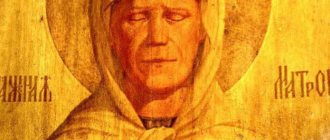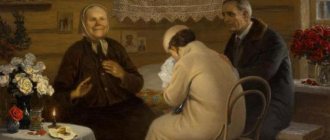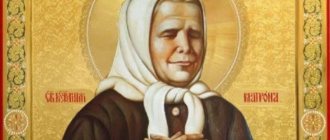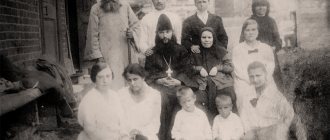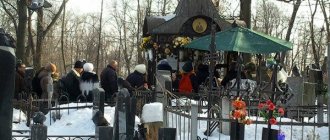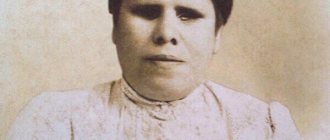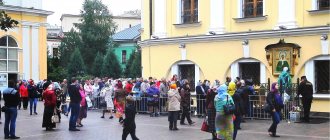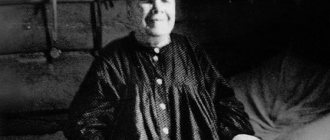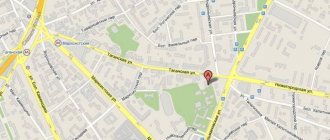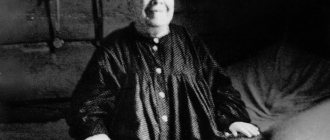Blessed Mother Matrona was born in the village of Sebino, Tula province. The future saint was born here in 1881 and lived in her parents' house until 1925.
Matrona's monastery did not survive the turbulent years of revolutions and wars. Today the village is flourishing in worldly and divine grace thanks to an outstanding countrywoman, the efforts of local authorities and the work of admirers of the Holy Elder.
Monument to Matrona in Sebino
Where is Matrona's homeland located?
The village is located eleven kilometers from the famous Kulikovo field, where the battle of Russian and Tatar-Mongol troops took place.
Some time ago, the reverend old woman’s native village began to be transformed and improved. The funding was provided by local and regional governments. The settlement currently has a variety of attractions that attract visiting people.
- A grandiose worship cross has been erected in the village, and near the road, at the turn into the village, there is a special sign on which is attached an icon of the righteous old woman.
- Orthodox believers come here to be inspired, spiritually relax and absorb the atmosphere of the places where Blessed Matrona began her life's journey.
- The locality is proud of two monuments erected in honor of the great saint of God. The first one stands in the rotunda built near the museum, and the second one is located on the street. During the period when there are a lot of pilgrims in these places, the monuments are literally buried in fresh flowers.
- Matrona’s home was close to the Church of the Assumption of the Virgin Mary, and today a museum has been built on it in honor of the saint.
Monuments to Matronushka
Today, everyone who comes to worship the holy place is greeted by the “Greeting Matronushka” - a 3-meter monument by Dobaev. It was installed at the entrance to the village in May 2015. Matrona, deprived of the ability to walk since her youth, after her death seemed to rise above her native land.
The second monument to the old lady is covered with a rotunda and stands on the site where her father’s house once was. Matronushka sits with her blind face raised towards the light and her palms open. Her holiness is emphasized by a halo above her head and a dove above her shoulder.
Main attraction
In the village, on the site of the Nikonovs’ home, a museum was built, which attracts pilgrims from Russian cities.
Hegumen Agafangel notes that this memorial building is extremely important for Orthodox believers. Those who come can see with their own eyes that Blessed Matrona led a virtuous and ascetic life, which will serve as a shining example for ascending the right spiritual path.
The museum is open from nine o'clock in the morning to five o'clock in the evening. On Tuesday the attraction is closed for the holiday.
- The building contains more than a hundred exhibits that recreate the life of that time. Pilgrims and ordinary tourists can see here materials on the history of the village of Sebino, manuscripts about the life of Saint Matrona, a large collection of icons, as well as objects of folk art (shirts, chests, spinning wheels, etc.)
- The territory of the complex is constantly being improved; local authorities monitor order and appearance. People admire the large number of spireas, cinquefoils and various willows. Within a few years after the opening of the museum, more than 100 thousand people visited its territory.
Queue
Pokrovsky Convent, 15th anniversary of the canonization of Matrona of Moscow. Photo by the press service of the Patriarch of Moscow and All Rus'. 2014
Even the 13th century preacher, Bishop Serapion of Vladimir, denounced some believers (or those who call themselves such) that they strive more for miracles, sorcerers and healings with the help of “water”, “strawberries” than for Communion and prayer... And modern priests are in pain They say: “On Epiphany, on the “honeyed” Savior, on Palm Sunday - the church is packed, there’s nowhere for an apple to fall. People are jostling, rushing to bless honey, apples, willows, to collect more holy water <...>, while Christ offers every day at the liturgy something incommensurably greater - Himself. Give us some honey and some water!..."
Therefore, it happens that a person savvy in matters of church teaching has a hard time getting in line at the Intercession Monastery, where one can hear so many conversations about which foot is the right one to approach the relics of the blessed one, and about removing the evil eye with the help of an icon, and much more “ amazing" things.
But is it worthy to blame people who stand here at any time of the year? Don’t they also take upon themselves an intuitive feat, without which it is difficult to imagine Christianity? A small contribution, transformed into labor - to come here, freeze in line or, conversely, suffocate from the heat, next to those whom God will send... This string, this line of human grief stretches for centuries, millennia. And no matter how enlightened we may seem to ourselves, knowing that Christianity is primarily about Christ, do we have the right to mock those who stand here in despair and horror before the blows of life?
“Icy rain, a piercing wind, a line of people goes around the temple... I’m dressed in light demi-season shoes, with a raincoat on my shoulders. And there are many of them, naked like me... I trample, I pray, I ask you to give health to my mother. Two hours passed. The cold sent a burning pain all over my body from my knees. And then I understand, that’s it... I can’t do it anymore. “Lord, have mercy, give me strength!” Another hour passed, the cold shackled the diaphragm, the feeling that the lungs were stopping breathing. I call my sister, cry, complain, ask for support in my decision to leave, I have no more strength. My sister listens, she feels very sorry for her beloved sister, she sobs with me, but remains silent. She understands, this is for mom’s sake... for mommy’s sake...” This is the story of Elena Alexandrova (Elena Alexandrova. Mom and Mother. - Pravoslavie.ru website), one of the women in the queue, one of thousands. And my mother’s health, by the way, has improved...
What words could describe the difficult and righteous life of Blessed Matrona, and this line, and hundreds and hundreds of stories of gratitude from people for the help received through the prayers of the saint? Perhaps these? Come to Me, all you who labor and are heavy laden, and I will give you rest (Matthew 11:28).
Christian sources
Believers understand that drinking consecrated water is comparable to hearing the Word of God. There is a similar source on the territory of the village; it gives people healing and deliverance from ignorant worldviews.
- At some distance from the museum, believers can find consecrated fonts where they are allowed to take a dip. These buildings are closed and appear as wooden buildings with changing rooms and several main departments.
- The fonts are filled with water from an underground spring flowing at a depth of four meters. A white stone rotunda was built over this spring, the dome of which is crowned with an Orthodox gilded cross.
- On the outer walls of the fonts, pilgrims see photographs of the Church of the Assumption of the Blessed Virgin and the Matrona of Moscow herself. There are also notes with the instructions of the venerable old woman and the rules for washing in holy water.
Local church
In the village there is the Church of the Assumption of the Virgin Mary, which is the main building of the settlement. It was after the saint’s canonization that churches and monasteries began to be consecrated in her honor, and during her lifetime the future ascetic went to the local Assumption Church. Its construction began in 1892, and the church building was consecrated two years later. Inside there are icons depicting the Venerable Matrona and particles of her venerable remains, which were donated by Patriarch Alexy II.
- Behind the altar is the grave of St. Basil, who baptized the righteous woman at birth. Inside the cathedral, the very font where the little Matrona underwent the sacred rite is kept. Since the church is an architectural monument of the 19th century, the local government established surveillance over the building.
- The venerable saint came daily to the Assumption Church to listen to prayers and offer praise to the Lord. She practically grew up within the walls of God’s monastery; mother always knew that her daughter was spiritualized in a sacred place.
- The Church of the Assumption of the Virgin Mary attracts the attention of pilgrims both from the outside and from the interior. It is open daily from 8am to 8pm. The baths are open from nine to five o'clock. The rector of the temple is Priest Alexy (Lysikov).
On a note! In 1925, the reverend saint moved to the capital, this was due to the fact that Matrona feared for the lives of her loved ones. It was impossible to stay in one’s home, since a communist inspection could suddenly arrive, the goal of which was to exterminate Christianity. In Moscow, where the venerable old woman left the mortal world, she lived with friends and often changed places.
About the prayer help of the old woman:
If an Orthodox person wants to visit Matrona’s native land, he will find here many intriguing sights, surprising with religious tranquility and picturesqueness. Pilgrims want to visit the museum built in honor of the saint, as well as the church where she was baptized. In addition, nearby there are healing springs with blessed water, which provides healing from ailments.
Terrible years
Matrona’s life in Moscow came at the most terrible time: the end of the Civil War, poverty, hunger, the Yezhovshchina - the terrible years of 1937-1938, when people disappeared, an atmosphere of fear and denunciation reigned everywhere, and then the war came. A huge sea of human grief. And people reached out for consolation and hope, for healing of soul and body. They testify that God often revealed to Matrona the fates of those fighting at the front; through her prayers, those who were considered missing returned. To one woman, who received a “funeral” for her husband three times, the blessed one said: “Alive, he will come to Kazanskaya, knock on the window,” and indeed, the husband returned in 1947.
Moscow. Starokonyushenny lane no. 30. 1929 Here, in the Zhdanov family, Blessed Matrona lived from 1942 to 1949.
She told people words that in no way contradict Christianity: believe that God exists and by His power everything will be settled; wear a cross, pray, take communion more often, don’t believe dreams, never lose hope, learn to control yourself. She did not teach, she pitied people, stroked them on the head, gave specific advice in specific situations, often with humor, always with joy. She advised those who were sick to take communion more often, and the illness - even a serious one, be it tuberculosis or epilepsy - would recede. “We must control ourselves, endure”; “The Lord himself will manage everything!”; “Pray, ask, repent! The Lord will not leave you and will preserve our land.”
And wonderful things happened - these stories can be told endlessly - and the flow of visitors did not dry up. Much evidence of the saint’s help has been preserved, but less is known about her and the details of her life in the capital than about her affairs. In fact, her whole life boiled down to prayer and helping people. Those who knew her during her lifetime recalled that Matrona even had a hole on her forehead from the constant sign of the cross: the old woman prayed at night.
The grave of Blessed Matrona at the Danilovsky cemetery. 1952
The blessed one lived a difficult life and died quietly on May 2, 1952. She knew about her impending death and was worried about how to properly fold the arms in the coffin. When the priest who came to confess and give her communion, surprised by this, asked: “Are you really afraid of death?” “I’m afraid,” the blessed one answered ingenuously. And she asked to be buried at the Danilovsky cemetery, near the temple - “so that she could hear the service.” Her funeral service was held in the Church of the Laying of the Robe of the Lord on Donskaya Street by priest Nikolai Golubtsov. On May 4, the day of the Myrrh-Bearing Women, with a large crowd of people, the blessed one was buried at the Danilovsky cemetery, next to one of the few churches operating at that time.
On May 1, 1998, with the blessing of Patriarch Alexy II, the honorable remains of the old woman were transferred to the Pokrovsky Stauropegic Convent on Taganskaya Street, where they remain to this day. Blessed Matrona was canonized as a locally revered Moscow saint in 1999, and five years later her church-wide canonization took place. In 2013, the Holy Synod established an additional (in addition to May 2) day of remembrance of the blessed one, in memory of the discovery of her venerable relics - March 8 (according to New Art).
The village of Sebino is the small homeland of Saint Matrona of Moscow
Sebino village, Kimovsky district, Tula region
Sebino , which is located 11 kilometers from Kulikovo Field, is the small homeland of the holy righteous Matrona of Moscow. It was here that Matrona Dmitrievna Nikonova was born in a large family in 1881. As the life tells, even at a young age she received pilgrims in her parents’ rural house, before moving to Moscow (in 1925). This is why local residents call the holy old woman “Matrona Sebinskaya”.
Matrona’s parents lived in Sebino until the end of their days. Unfortunately, their burial places in the cemetery have not survived and residents do not know their exact location. Also, the house in which Matronushka was born has not been preserved, but the place where it was located is known. Now there is a memorial stone installed here.
Several years ago, with the help of local and regional authorities, the village of Sebino began to be transformed and improved. A museum complex was created here, which became a place of attraction for pilgrims from many cities. Every year thousands of Orthodox believers visit the village to pray and gain spiritual strength. The settlement has a number of attractions that attract tourists.
Temple and Museum of Matrona in the village of Sebino, Tula region
Church of the Assumption of the Blessed Virgin Mary in the village. Sebino
Matronushka was a parishioner of the Assumption Church and always attended services when she was able to walk. She literally grew up in church, going to services first with her mother, then alone, whenever possible. Not knowing where her daughter was, the mother usually found her in the temple. She had her usual place - on the left, behind the front door, near the western wall, where she stood motionless during services. She knew church hymns well and often sang along with the singers. This church building is beautiful not only outside, but also inside.
Assumption Church Sebino is open daily. Opening hours: from 8:00 to 20:00. Font from 9:00 to 17:00. The rector is Priest Alexy Lysikov.
Museum of the Matrona of Moscow in the village. Sebino, Tula region.
As Abbot Agafangel (Boldin) noted, this museum is of great importance for the diocese and for believers. “Establishing chapels or worship crosses near the place of life of a saint is our ancient spiritual tradition. And in this case, a museum was built where the entire way of life of the blessed one was recreated. Saint Matrona sets an example for us all - no matter where and in what conditions a person lives, whether he is completely healthy or has congenital ailments, he can glorify God with his whole life,” noted Abbot Agafangel.
The Matrona of Moscow Museum in the village of Sebino, Tula region, is open from 9 a.m. to 5 p.m. without a break. Day off is Tuesday.
Sights of the village of Sebino - the birthplace of Matrona
Monument to Saint Matrona of Moscow in the village. Sebino
The closed fonts are a log building with two compartments and changing rooms. On the outer walls there are photographs of the Church of the Assumption of the Blessed Virgin Mary and Matrona, her instructions on how to wash yourself with holy water. The baths are filled with water from a source located in a well at a depth of more than 4 meters and constantly fed by a spring. A white stone rotunda was built above the source, topped with a dome with a gilded cross.
In addition, a majestic worship cross was erected in the village of Sebino. And at the turn to Sebino-Ustye there is a sign with an icon of the righteous woman. The territory of the museum complex has been landscaped. 400 spirea and cinquefoil bushes, weeping and silver willows are planted here.
Pilgrims from different regions of Russia and neighboring countries regularly come to Sebino. In just two years from the opening of the museum, about 100 thousand people visited Matrona’s homeland. It is especially crowded here on the days of Matronushka’s memory (May 2, November 22 and March 8). The museum complex is constantly developing, and the village is being improved.
Childhood and youth
A girl was born in the village of Sebino, Epifansky district, Tula province. Her parents - Natalya Nikitichna and Dmitry Ivanovich Nikonov - did not live well; at that time they already had three children. Therefore, having become pregnant for the fourth time, Natalya decided to give the child to an orphanage, since she understood that they would not be able to feed another baby.
Photo of Matrona of Moscow
But before giving birth, the woman had a dream in which a bird with the face of a man, but without eyes, sat on her chest. In the morning, Natalya Nikitichna regarded what she saw as if God would help them, and changed her mind about giving the child away.
This dream turned out to be prophetic - the daughter was born blind, her eye sockets were missing, and her eyelids were tightly closed. The parents immediately realized that their girl was special. They found a cross-shaped bulge on the baby's chest. And during the baptism, a miracle happened: when the priest lowered the girl into the font, a column of fragrant fog rose above her. The priest immediately said that the child was holy.
Baptism of Matrona of Moscow
As Matrona’s mother said, in infancy she even refused to eat breast milk on Wednesdays and Fridays, as if she was fasting. These days she mostly slept.
The girl did not find a common language with the local children, they called her names and insulted her, they could whip her with nettles and even push her into a ditch, after which they laughed at how the blind woman was getting out of it. Therefore, Matrona spent more time at home and in the Church of the Assumption of the Mother of God, which stood nearby.
Matrona of Moscow - Matrona’s birthplace
Greetings, dear readers of the moikomputer.ru blog. I suggest you read the article about my little magical journey. Last week I went to the homeland of Matrona of Moscow, if anyone doesn’t know, she’s not even from Moscow, but from Tula if we take into account her homeland.
Because she was born in the village of Sebino, Kimo district, Tula region.
This is 15 kilometers from the Kulikovo field, the same one where on September 8, 1380, the legendary battle took place between the Russian army led by Prince Dmitry Donskoy and the Golden Horde, led by Mamai.
But few people have any information about Matrona’s homeland, although many people know her. For example, take my city Lipetsk, the relics of the Holy Elder Matrona of Moscow are brought here quite often and not many people know about her true homeland.
From the history of Sebino
The village is located in the Tula region and belongs to the Kimovsky district. Once upon a time this was probably a real bear corner, which is reflected in the name: Staro-Medvezhevo. The settlement received a certain status by becoming the property of the governor. But its original owner was Tatar Sobina. This is apparently where the modern name came from.
It has long basked in the rays of Russia’s historical glory: approximately 20 km separates it from the famous field where the Battle of Kulikovo took place. The Holy Assumption Church, according to legend, was founded exactly where the convoys and the camp of Dmitry Donskoy’s soldiers were located. And there he discussed the upcoming battle with the army.
At first wooden, in the landmark 1881 the church was rebuilt in a reliable stone version. And in November of the same year, a blind girl Matrona was born into the large poor Nikonov family.
Read a detailed article on the topic: “The Life of Matrona of Moscow: the story of the Holy Mother.”
This is the year her life calls:
Dear friends! There are no advertisements on our site; it exists only thanks to your donations. We would appreciate any help! Donate
According to various sources, there are other dates (1883 and 1885), but all documents unanimously call Sebino the place of her birth.
Also, all sources claim that this temple was little Matrosha’s favorite place. When the mother did not know where to look for her daughter, she came to the Assumption Church and often found the child on the left behind the temple doors.
Background to the trip to the homeland of Matrona of Moscow
Why did I suddenly go and where did it all start? We have the city of Zadonsk in the Lipetsk region - this is the center of Orthodoxy in Russia; in these places there are so many interesting things, I don’t even mean only the religious theme.
There are ancient churches, male and female monasteries, holy springs, museums, monuments and even a magical oak tree where pilgrims are sure to come. And in the early 90s, the oak streamed myrrh and scientists became interested in it.
In Zadonsk there is even a small Nature Reserve “Galichya Gora” and plants grow in it that cannot be found anywhere else both in Russia and in the world.
There are two parks that are located in nature and their scale is amazing even for such megacities as Moscow.
In the Zadonsk region you can meet people from all over Russia while being on the territory of the women's St. Tikhon Transfiguration Monastery near the Holy Spring, founded by St. Tikhon.
By the way, next to the source there is a Holy Font, which has healed many true believers. That’s why there are always a lot of people here from different Russian cities; they take a dip and collect water in huge quantities!
And when I arrived there again, I started talking with a woman from Tula, learning from her about the native places of the blessed Matrona.
So that year I wasn’t able to go to Sebeno, but the next year my wife and I went and after that trip my chronic illness, which lasted more than 15 years, went away!
I don’t know how to explain this, but when I took the last tests, I was taken off the register, diagnosed healthy, a miracle or a coincidence?
Brief acquaintance with Saint Matrona
Matronushka was born on November 22, 1881 in the family of ordinary peasants Dmitry and Natalya Nikonov. God did not give her vision; her eyelids were closed; she did not even have eye sockets.
As soon as she learned to walk, she began visiting the Assumption Church, which was literally two steps from their house. At the age of seven, she showed the gift of foresight and healing; people from different areas reached out to her for healing.
At the age of 17, she suffered a new blow of fate: the girl lost her legs, she became unable to walk, but her love for people could not go away and God’s gift remained with her, she did not refuse anyone, she helped everyone.
At the age of about 45, she moved to Moscow, where she continued her good deeds healing people. She died on May 2, 1952.
You can read more detailed information about Matrona on the sebino-matrona website.
My trip to the village of Sebeno, Tula region
This year I happened to go alone, it all happened spontaneously; I was not far from these places and decided to stop by, deviating from the previously planned route.
I’ll start in order, my path ran through the city of Dankov and passed it without stopping. On the way back, I stopped to take a video, if I’m not mistaken, in the village of “Ivanovka” about the old temple that I saw.
Further, there was nothing interesting along the way, only small settlements as villages, roads and fields.
Already at the entrance to Kulikovo Field I met this Stella.
In front of the Kulikovo Field there is a monument where Sergius of Radonezh blesses Dmitry Donskoy.
While passing, I took a photo of the monument in honor of the victory on the Kulikovo Field.
In fact, the territory of the field is very large, there are churches, many museums, monuments, historical information, you can even watch a film on the topic, a lot of interesting things. Everything is scattered at different ends of the field, and this area is probably more than 10 km.
And finally, almost at the end of the path to the small homeland of St. Matrona, at the turn there is such a monument that it is simply impossible to drive past; it is very clearly visible from any place.
On the way I took a photo of an abandoned church. I don’t remember the name of the village, but after it there will be the village of Sebeno.
The time is 18:41 and here is the long-awaited sign: 3.3 kilometers left!
Entering the village we see on the right side a tonar and a flower kiosk (which was not there the first time) a little further there is a stop.
There are no shops or hotels, especially so you can only spend the night in your car or take a tent. There are probably only a couple of dozen houses here, but a sufficient number of believers always go to services, as you can see in the photo (taken in the morning) the cars of visitors, although the service had already begun to leave by the time the service was over for more than an hour.
Also, a considerable number of visitors park their cars near the temple, although the license plates are mostly from Tula.
A walk through the village of Sebeno, the birthplace of Matrona
I arrived early to get used to the local energy a little.
Coming here for the second time, I feel the good energy of some external forces, so to speak, I feel very calm and good here.
I stop at the backyard of the temple, about 50 meters from it, there is a small nickel near the road leading down to the font and the holy spring, which is located at the bend of the Mokraya Tabola River.
First of all, I decided to go get some holy water and, of course, swim in the holy spring, which is about 500 meters away, not counting the descent down the wooden stairs.
Immediately after the descent there is a white well under the dome, but it is either decorative or not yet operational.
The structure of the font, both outside and inside, is made of wood and consists of three segments, on the left is the so-called dressing room for men, and on the right for women. And the building in the middle is divided in half and has 2 fonts on both sides.
Sebeno font inside view
Having bathed and felt significantly invigorated, he went to the source to get some water.
Next, I went to the car to have dinner, after which I decided to take another overview of the Church of the Assumption of the Blessed Virgin Mary, as well as marking the place where Matrona’s house stood and other holy sights of the village of Sebeno.
On the territory of the temple there is the grave of Archpriest Vasily Troitsky 1830 - 1904, who baptized Matrona! In the church there is the very font in which the future saint and her baptismal cap were baptized. By the way, the church was built in 1777.
Melodious bells.
After I shot the video review, I went to sleep in the car, I was very tired from the road, so I immediately fell asleep, I woke up at night from the cold, I had to start the car and warm up the interior, but I still slept well.
Church of the Assumption of the Blessed Virgin Mary – Confession and Divine Liturgy
In the morning I went to church at 7:45 in order to be in time for the ritual of confession with communion. I was the first to confess, but for some reason not many expressed such a desire this time.
It was not very convenient for me to answer the priest’s questions. Do I know what prayers? My answer is no.
Do I have the Gospel and other books at home? My answer is also no.
To which he answered me - I definitely need to buy it in advance, asking if I have the financial ability to purchase literature.
He also advised me to find on the Internet the book “Ascetic Experiences” by St. Ignatius Brianchaninov.
I gave instructions about my sinful actions, I kissed the cross and left. Afterwards there was communion of Cahors and mallow, and then the Divine Liturgy began, which is not very easy to endure if you have problems with your legs and spine.
But there are benches for this case, although no one used them. The priest performed a cleansing ritual, walking with a censer throughout the church, there was a delicious smell of incense.
There was also a sprinkling of holy water on everyone who was in the church. I also noticed that whoever confessed, the priest watered them more heavily.
The choir sang mesmerizingly beautifully, and just reading the prayers was pleasant to listen to and admire, there is something bewitching and even wonderful about it.
It was very interesting to look at the whole process that was happening, everything was very clear and verified without errors or hesitations!
I don’t know how everything happens in an ordinary church; I have nothing to compare it with; I was only at the service for the second time, and it was in this Church of the Assumption of the Blessed Virgin Mary in Sebeno.
Before the end of the service, the Priest analyzed each phrase, I don’t know its meaning from the Bible or the Gospel.
He read out a few words and in his own words began to explain with examples from life how to understand the written section. Then he read no more than a paragraph, but he explained everything so interestingly that from one sentence it turned out to be a big, fascinating story.
But it all seemed to me, to my regret, to end very quickly.
Then I saw my grandmother at a table with mugs and malt milk, it turns out that whoever received communion must come up and drink from the mug and take the malt milk, I didn’t know this.
The main thing was that everything was enough, and I went through the rite of confession and communion according to all the rules. The contents of the mug resembled highly diluted Cahors in terms of volume; I drank about 200 grams.
After that, where they buy candles, everyone was given milk again, and it was all over. When I left the church, I felt in my soul a previously unfamiliar joyful feeling, lightness and purity, probably.
The bells were ringing, some went to the Matrona Museum, others to see the sights, others for holy water and a font, and I was one of them.
